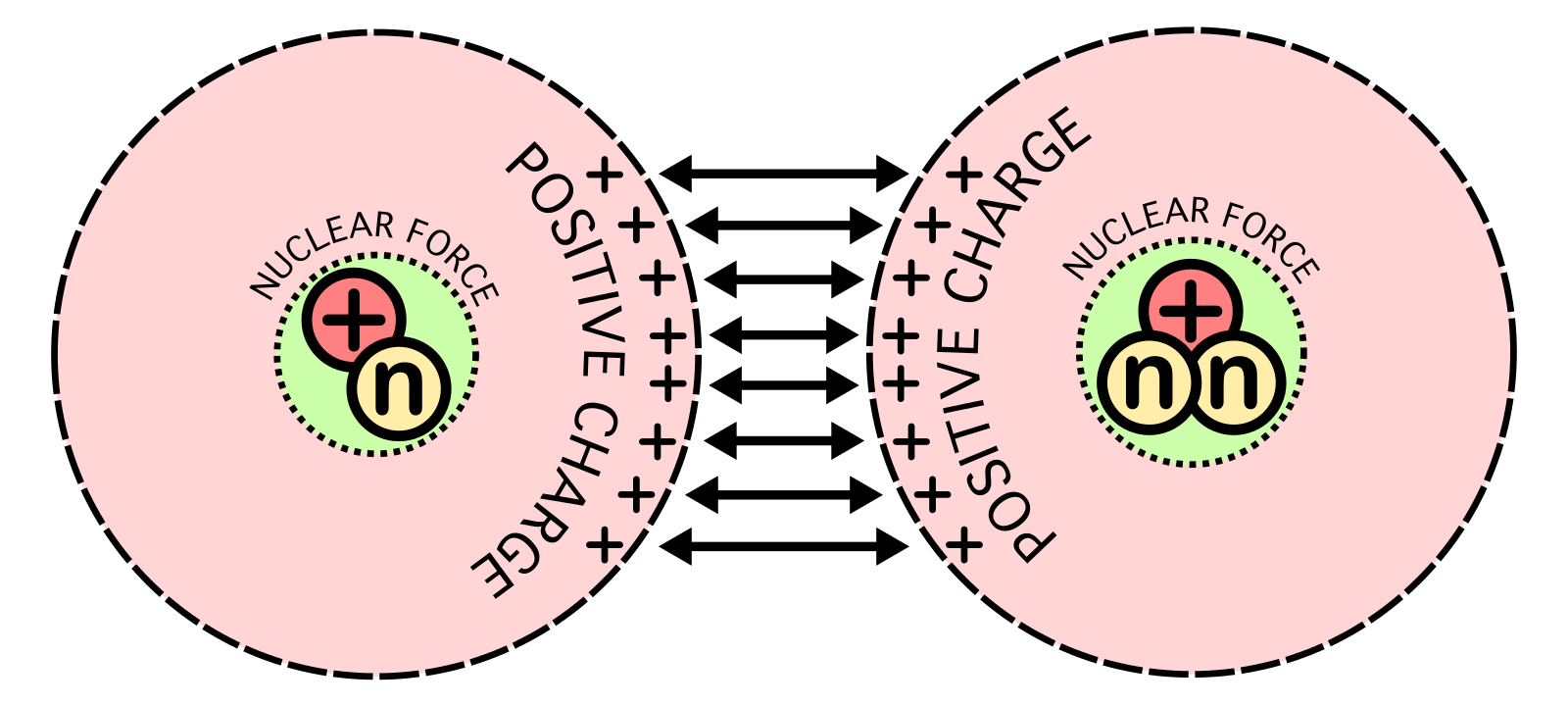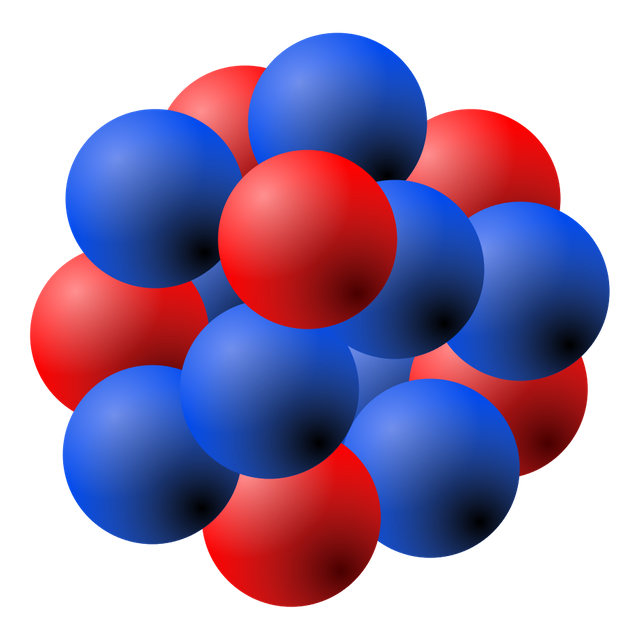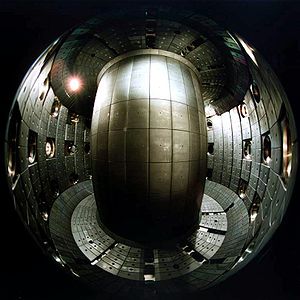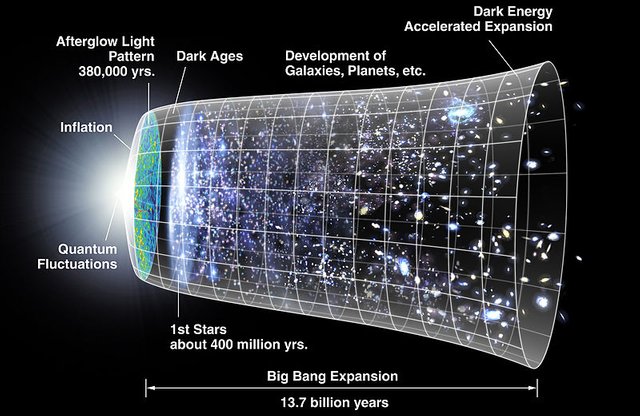ENERGY VIABILITY IN FUSION AND THERMONUCLEAR REACTIONS
The term fusion reaction is the combination of two light nuclei to form completely new nuclear specie, accompanied by the release of energy. This is a reverse process to fission reaction in which a heavy nucleus interacts with a neutron and splits into lighter ones, also with an attendant energy release. Common to both processes is the re-arrangement of the nuclear structure of the interacting nuclei to form new ones, with a resultant energy conversion.

Credit : Wikimedia Commons
In fusion reaction the reacting nuclei posses sufficient relative kinetic energy to overcome the electrostatic repulsion of the positively charged nuclei before nuclear fusion can take place. This involves raising the thermal motion of the fusing nuclei to temperatures of millions of degrees centigrade.
In spite of the high energy input requirements for the attainment of nuclear fusion, research efforts have been sustained over the years, aimed at ensuring that fusion power reactor is an ultimate reality. This is primarily because fusion is a clean energy source that poses little or no radiation hazard and waste disposal problems in comparison to fission reactors.
APPROACHES OF FUSION REACTIONS
The main purpose of fusion energy research and developmental efforts is to attain a sufficiently high fusion reaction rate in a sufficiently small volume and under controlled conditions, in order to produce power at acceptable terms and competitive costs. This has proved a difficult challenge resulting in a number of approaches that are concurrently pursued.

Credit. : Wikimedia Commons
The basic problem of fusion reaction lies in overcoming the Coulomb barrier , VB between the fusing nuclei. For the lightest nuclei of P, D and T involved in fusion reactions, VB has values in the range of 150-350KeV. The fusing nuclei needs to be raised to temperatures in the range of 1.74×10 9_ 4.06×10 9 K. Before such enormous temperature is attained, the heated fusion fuel atoms become ionized and constitute a plasma. This creates the additional problem of containing migrating charged ions in the reaction core in order to meet the ion density requirements for thermonuclear reaction.
The most widely used approach for containing the plasma is known as magnetic confinement. This consists of heating an ionized initial hydrogen gas to a sufficiently high temperature in order to increase it's probability of fusion.The migrating ions then need to be contained for sufficiently high temperature in order to increase it's probability of fusion.
The migrating ions then need to be contained for sufficiently long time at a sufficiently high density in order to provide a net energy gain. Since charged particle motion is greatly influenced by magnetic field lines, it is conceived that the ions can be contained by either pulsed or steady-state operation of a complex system of magnets and coils.
Another common approach is to confine the fusion fuel atoms and nuclei by inertial forces. This involves the use of small hydrogen pellets surrounded by layers of pusher and ablator materials. An intense pulse of charged particles or electromagnetic radiation strikes the pellet from several evenly spaced directions. The result is the ablation of the other layer and consequent creation of an inwardly directed pressure wave. This has the effect of increasing the pellet core density sufficiently to cause fusion reactions before the pellet disassembles.

Credit : Wikimedia commons
ENERGY VIABILITY OF A FUSION SYSTEM LAWSON CRITERION
This asserts that the recovery energy from a fusion reactor must exceed the energy supplied to sustain the fusion reaction. There are two critical requirements for achieving sustained fusion reaction.
After the thermonuclear temperature has been attained, the plasma need to be contained long enough for sufficient reaction to occur. This expressed in terms of a factor Te, called the energy confinement time, which is equivalent to the ration of the total heat energy of the plasma divided by the total rate of energy loss to the surroundings.
The particle density n m-3 which affects the reaction rate, the power density, and the confinement time be sufficiently high. The product nTe represents confinement time per cubic metre of plasma. This is the specific form of Lawson criterion, and it sets specific performance threshold for the fusion reactor.
ACCORDING TO BIG BANG THEORY STELLAR ENERGY
According to George Gamow, at one time all the matter in the universe was packed into a dense mass at temperatures of many billions of degrees. Suddenly the universe was formed in a gigantic explosion, the universe started to expand, and the temperature decreased until such densities and temperature were reached at which galaxies started to be formed. Evidences for the Big Bang Theory stem.
- The experimental observation that we live in an expanding universe in which all galaxies around us are moving away from us and one another at enormous speeds, in some cases up to 160 million kilometers per hour. This probably implies that the galaxies were in one unit at some stage.

Credit: Wikimedia Commons
- The discovery that earth is bathed in a faint glow of radiation coming from every direction in the heavens. This radiation has exactly the pattern of wavelengths expected for the light and heat produced in a great explosion.
The sun is only one of the 100 billion stars which are held together by gravity in our Galaxy. The stars in the galaxy revolve about the center just as the planets revolve round the sun. It is generally agreed that the first stage in the process of the evolution of stars is the localised fluctuation in the density of the inter-staller hydrogen gas; any local increase of density tends to grow as gravitational attraction brings in more hydrogen. As the cluster grows heavier and contracts more and more, the temperature inside rises because of conversion of the gravitational potential energy into kinetic energy.
At some stage in the process of contraction the temperature at the center of The Star must become sufficiently high that collisions between nuclei take place with sufficient relative kinetic energy of the particles so that nuclear reactions occur with the subsequent release of energy. Such collisions must occur with sufficient frequency to account for the rate at which energy is known to be radiated by different classes of stars.
REFERENCES
Nuclear fusion
Nuclear binding energy
Big Bang nucleosynthesis
Lawson criterion
Coulomb barrier
Plasma physics
But there are alternatives that are very well alive. We must stay open minded (even if standard cosmology seems to be good, it is not perfect).
But there are alternatives that are very well alive. We must stay open minded (even if standard cosmology seems to be good, it is not perfect).